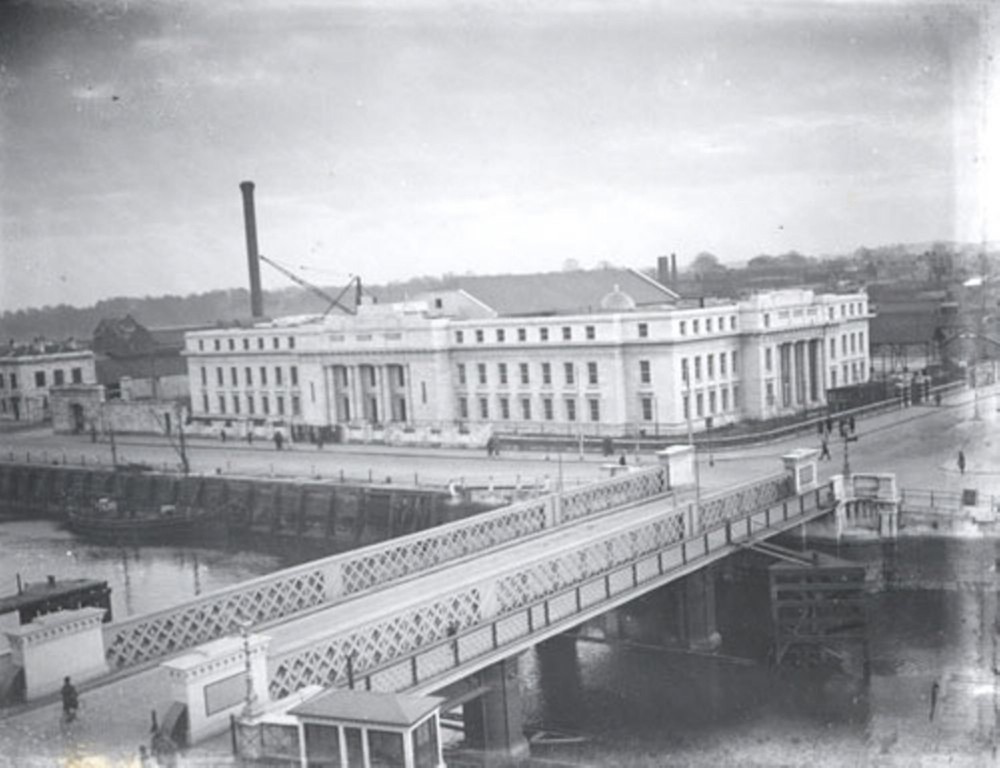
Kieran’s Our City, Our Town,
Cork Independent, 1 September 2011
Planning a City Hall
In an effort to mark the upcoming 75th anniversary of the official opening of Cork City Hall on 8 September 1936, I wish to note some interesting histories about its evolution before its opening. Three years after the arson attack on the building (1920), a town hall competition looking for architects took place in July 1923. Plans were put up for public inspection in the Cork Municipal School of Art. On the 29 March 1924, Jones and Kelly architects were the chosen winners of the competition. The architectural partnership, between Alfred Edwin Jones and Stephen Stanislaus Kelly was formed in Dublin in 1919. The following year they won the competition for Ballymena Town Hall and in 1923 gained wider recognition as the winning entrants in the Cork City Hall competition. A contractor was then sought. Tenders were sought in November of that year.
However, in 1923 and 1924 the Irish Government found it necessary to remove the members of several local authorities and replace them temporarily by paid commissioners. Among the bodies removed were the Dublin and Cork city councils. Cork Corporation itself had been dissolved in 1924 after an investigation into its activities demanded by the Cork Progressive Association (which was founded in 1923). After some experience of the work of the commissioners in these cities there was a body of opinion in favour of retaining the commissioners after the elected councils were eventually restored.
The priorities of Cork Commissioner Philip Monahan were not in the rebuilding of City Hall. Housing and slum clearance became his priorities. a local committee of commercial and industrial interests was formed in Cork in 1926 to consider a scheme of city government and it appeared that the council-manager plan of city government would be acceptable. After discussion between the Minister and local representatives, the Minister, Richard Mulcahy, introduced as a Government measure the Cork City Management Bill, 1929 and it became law despite at times, vehement opposition to it. Dublin city got its Management Act in 1930 and was followed by Limerick in 1934 and Waterford in 1939.
With the return of Cork City councillors in 1929, focus was again on the rebuilding of a city hall. In April 1929, a sub committee was appointed to look at the costs of a new building. Connected with that, public discussions also took place in local and national newspapers in the ‘letters to the editor’ pages. One such discussion took place in late April 1929 when writer Daniel Corkery proposed a site for the new City Hall near Cork’s Coal Quay. He argued that the old City Hall site was not the way forward for a new building because of its close proximity to deep water quayage, the Customs House and Harbour Offices, the heart of City’s industrial and commercial activities. His proposal took in a semi-circular area extending from the corner of Kyrl’s Street, Cornmarket Street and looking down Lavitt’s Quay towards St. Patrick’s Bridge and swinging round Kyrl’s Quay to the northern end of Kyrl’s Quay.
At a Council meeting near the 23 October 1929, the Lord Mayor, Alderman Sean French noted that an agreement had been arrived at with regard to the site of the City Hall. The City’s Town Planning Association had agreed to the old Anglesea Street site but suggested that the main entrance should be on Anglesea Street and not on the quayside. With the councillors pushing the project, further discussion appeared in the makeshift council chamber in the Crawford Art Gallery.
In mid January 1932, the Corporation decided to ask the Minister for Local Government for his consent to go ahead with the job, on the assumption that they would get a £40,000 loan, plus cash on hand amounting between £12,000 to £15,000 and leave the borrowing of the balance of an estimated total of £150,000 to a future date. At a Council meeting in early February 1932, it was reported that three tenders had been received for the erection of the new City Hall. The City Manager noted that the three tenders did not conform to the terms of the advertisement, in regard to prices or to the construction time limit. It was noted that if the furnishing was taken out of the bill, the price for the completion of the building at least could be paid for. Hence the tender of John Sisk and Sons, Cork at £139,870 was accepted and in the last week of March 1932, the contract for the rebuilding was signed. In the event of certain provisional items being included, an extra £11,000 would be added.
The foundation stone was laid on 9 July 1932 by President of the Executive Council, Eamonn DeValera. In previous articles I have written about this. The foundation stone bore an inscription in Gaelic to the effect that on that day DeValera had laid it. He spread the mortar with a silver trowel and announced in Irish that the stone was well and truly laid. He added in English that he hoped that the new building would be “symbolic of the prosperity and the future glory of the country, to come as a result of the sacrifices, which had been made by the men like those to whom the Lord Mayor had referred to, Terence MacSwiney and Tomás MacCurtain”.
To be continued….
Captions:
606a. Ruined old Cork City Hall Building (pictures: Cork City Library)
606b. Cork City Hall under construction, February 1935
